Heavy snow and blizzard-like conditions hammered Cape Charles and the lower Eastern Shore. With accumulations in some areas close to 11”, and with winds gusting between 50 and 60 knots, severe drifting has occurred along streets and sidewalks. With temperatures predicted to remain in the mid to low 20s, road conditions will continue to be hazardous.
Some minor plowing has occurred along Mason Avenue, but it is still relatively unpassable. Most streets are seeing moderate to high drifting.
The CBBT was closed early Thursday, but has since reopened with level 4 wind restrictions, and speed restrictions to 25 mph.
Snow is expected to end by Thursday evening, with high winds in effect until morning.
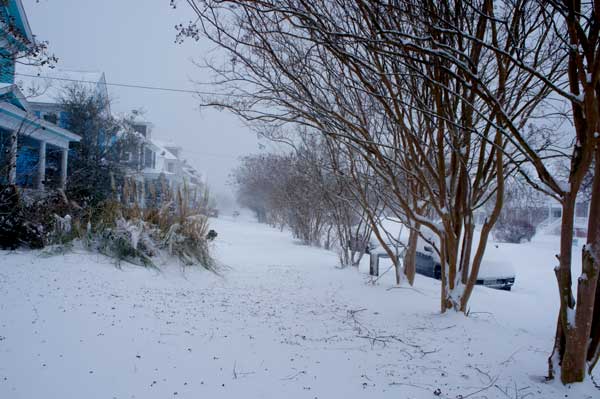


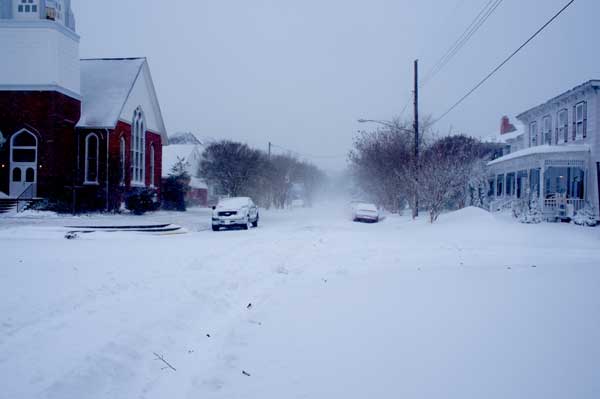


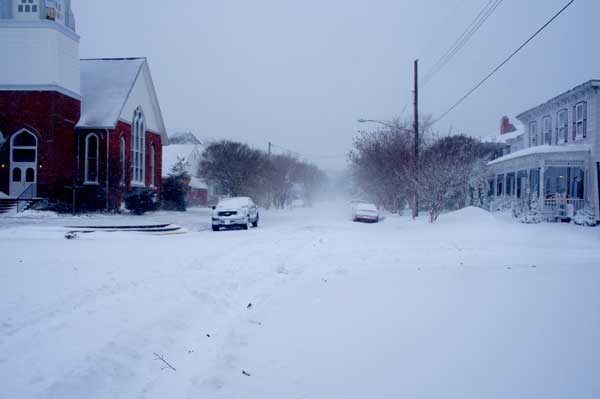
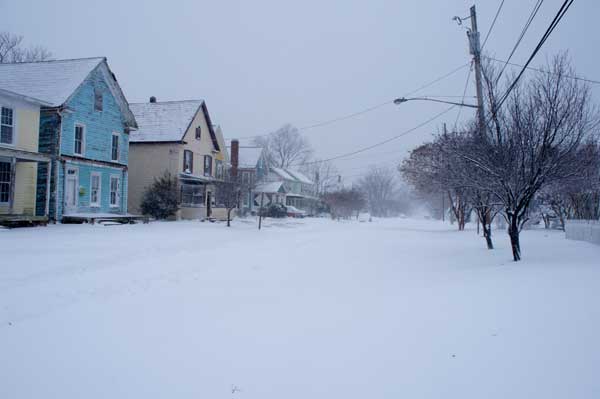
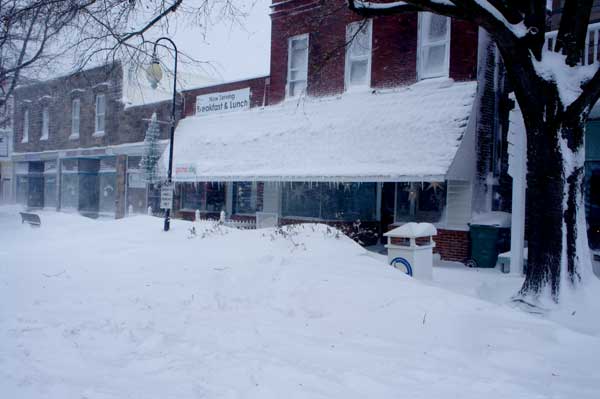
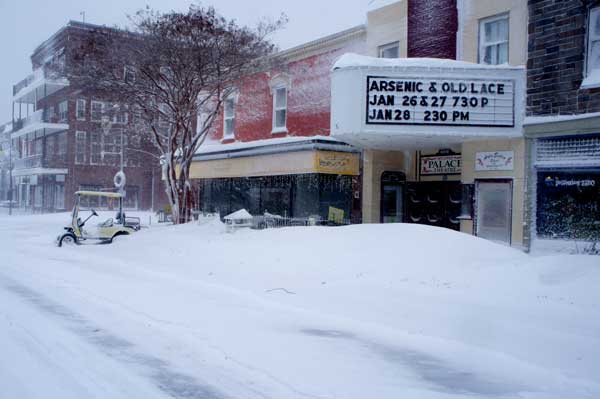

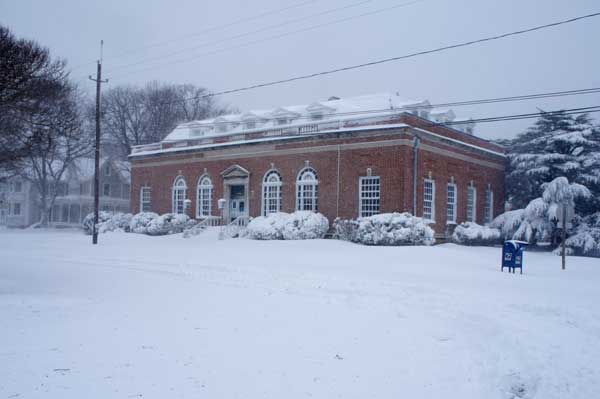

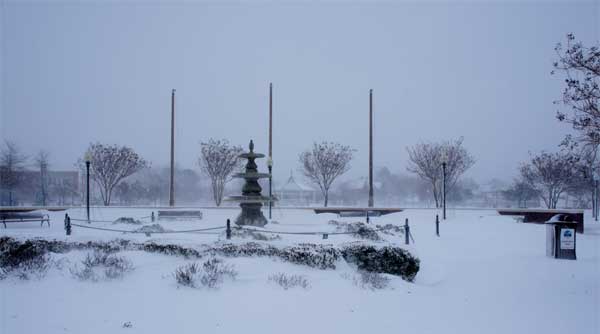
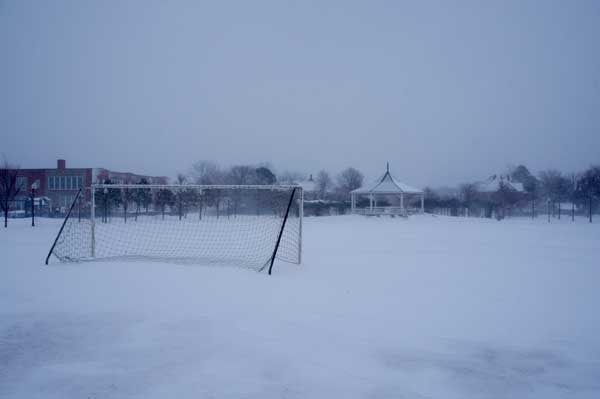
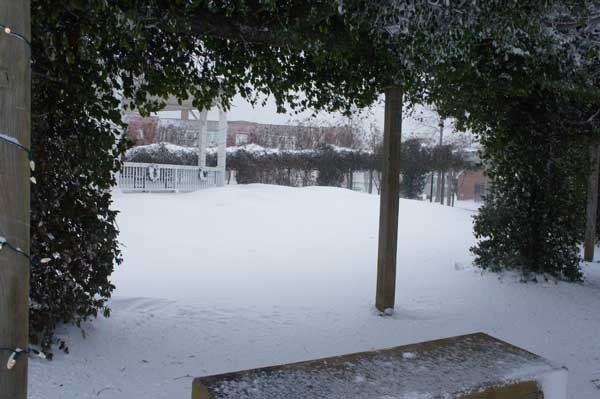
Brrr! Thanks for these pics, Wayne, since I’m not about to venture out! I moved here in the fall of 2016 with the understanding that the Eastern Shore had less severe winter weather than further west in the state. Ha! Guess we can blame this on the crazy weather patterns which now seem to have become the norm. (Don’t get me started on climate change …)
TRUMP TRUMP TRUMP!
Solved global warming in one year!
Yeah, right.
Part of the reason it is now so cold is that hot air rises, and as it does, cold air, which is more dense and flows more like water, is drawn into the “vacuum” caused by the hot air rising, since nature does not tolerate vacuums, except perhaps inside Trump’s head, where it is said a perfect vacuum exists, but that is for a different thread.
The point is, Jim, that Trump has put out so much hot air in the last so many days that to replace it, cold air has been sucked all the way down from Siberia and the north pole to replace it, which is why it is so cold at ground level.
So Trump hasn’t solved global warming, and let’s face it, he can’t, because he doesn’t understand science, and doesn’t believe in it and he is simply too stupid to know the difference between climate and weather.
I’m thinking that Jim was being facetious. At least I hope so.
That was great!!!
At least on the East Coast! West Coast next year, the whole world the year after that.
Oh, years ago this was not unusual here at all.
should be Eastern Shore Lady
Come north to escape the snow.
You are getting it worse than we are in upstate New York, although to the east, it will be a mess.
Love the photos. I wonder if it’s a record snowfall for Cape Charles, and hope there aren’t any power outages.
Wow! I
Just left on Tuesday and headed home to D.C. I was supposed to come back to CC today !!
So sad for you all. It is colder here in the Maryland suburbs of Washington, DC, but at least we got little snow.
Kudos to the Cape Charles Facilities Department for their quick action plowing the streets. Don’t know what we would have done if there were a medical emergency and those streets weren’t plowed.
If you really want to know about ‘Global warming’ DO NOT ASK AN ENVIRONMENTAL ENGINEER. There very existence DEPENDS upon AGW being a valid theory………errrrr, computer MODEL.
Ask a Geologist.
Ask a geologist about global warming?
Why a geologist, Mike?
According to Geology.com, (yes, I am cutting and pasting this information since it is so much more efficient than copying it word for word), geology is the study of the Earth, the materials of which it is made, the structure of those materials, and the processes acting upon them.
Did you know that, Mike?
And by the way, Mike, the study of geology is one of the traditional courses one would study if they wanted to become an engineer, especially an environmental engineer.
Geology, Mike, includes the study of organisms that have inhabited our planet, and an important part of geology is the study of how Earth’s materials, structures, processes and organisms have changed over time.
As to the existential question, “What Does a Geologist Do?,” geologists work to understand the history of our planet. Mike.
The better they can understand Earth’s history, the better they can foresee how events and processes of the past might influence the future.
Here are some examples:
Geologists study Earth processes: Many processes such as landslides, earthquakes, floods, and volcanic eruptions can be hazardous to people.
Geologists work to understand these processes well enough to avoid building important structures where they might be damaged.
If geologists can prepare maps of areas that have flooded in the past, they can prepare maps of areas that might be flooded in the future.
end quote
But you know what, Mike?
Developers who want to develop that land that might flood will get themselves a geologist on the make to say it won’t flood, because those maps can be used to guide the development of communities and determine where flood protection or flood insurance is needed, which is bad for the developers who want to develop that land for housing.
Cuts into the profits, don’t you know.
So you get yourself a geologist known as a “rented pencil” to give you the report you need, because who really is going to know the difference until the floods come, just like they did in Houston.
And geologists study Earth materials, Mike, because people use Earth materials every day.
For example, they use oil that is produced from wells, metals that are produced from mines, and water that has been drawn from streams or from underground.
Geologists conduct studies that locate rocks that contain important metals, plan the mines that produce them and the methods used to remove the metals from the rocks, and they do similar work to locate and produce oil, natural gas, and groundwater.
And here, maybe we have it, Mike: geologists study Earth history, because today we are concerned about climate change, so many geologists are working to learn about the past climates of Earth and how they have changed across time.
This historical geology news information is valuable to understand how our current climate is changing and what the results might be.
And did you know, Mike, and this is exciting news, over the next several years, the number of geology job openings is expected to exceed the number of students graduating from university geology programs, and starting salaries for geologists have recently ranged from $50,000 to $100,000 per year.
Not bad for somebody just getting out of college in my estimation.
But what do they know of climate change?
There is the question of the hour.
http://blogs.ei.columbia.edu/2014/07/11/what-geology-has-to-say-about-global-warming/
But I am sure you know more than Columbia University.
Which, of course, raises the existential question of does Columbia University know anything at all?
Given that Columbia University is nothing more than a pile of stones, I would of course posit that Columbia University doesn’t know doodly-squat about anything, including global warming and the subject of geology, which happens to be a traditional engineering subject.
Were you aware of that, Mike, that traditionally, engineers studied geology?
And did you know, Mike, that before it became Columbia University, it was known as King’s College, back before the Revolution?
Alexander Hamilton was a student there when the Revolution broke out, so he didn’t graduate, although that didn’t seem to hold him back much in life.
So a college degree isn’t everything, Mike, especially a Ph.D.
A Ph.D. means you know how to conduct research, Mike, it does not mean you actually know anything.
Do yourself a favor, Mike, and keep that in mind, so you don’t get fooled again.
As to that blog post you linked us to, Mike, from News from the Earth Institute at Columbia University entitled “What Geology Has to Say About Global Warming” by William Menke, who incidentally is a professor of earth and environmental sciences, it is well written and doesn’t confront me in any way, confirming as it does the positions I have taken in here on this global warming debate, such as these following two sentences:
The correlation of atmospheric temperature with carbon dioxide reflects the latter’s role as a greenhouse gas.
By absorbing heat radiated from the earth’s surface and re-radiating it back downward, it causes the earth’s surface to be warmer than it otherwise would be.
end quotes
Heat radiated from the earth’s surface would have to include the waste heat from nuclear power generating facilities which dump two-thirds of the energy generated by the nuclear reaction into the environment as heat energy radiated from the earth’s surface, which is then absorbed by the greenhouse gases and re-radiated back downward, causing the earth’s surface to be warmer than it otherwise would be.
For those unfamiliar with the excellent blog post Mike has referred us to, for our edification, the author tells us that he gave a public lecture in 2014 entitled, “When Maine was California,” to an audience in a small town in Maine, which drew parallels between California, today, and Maine, 400 million years ago, when similar geologic processes were occurring.
Afterward, a member of the audience asked him what geology had to say about global warming, and the blog post Mike linked us to is an expanded version of his answer back then.
And note that he uses the word geology to mean any element of the earth sciences that is focused on earth history, and he does not distinguish the many sub-disciplines about which a specialist would be familiar.
In the blog, he states, and I don’t dispute this, that geologists think of the last 50 million years as the recent past, both because they represents only about one percent of the age of the earth, and because plate tectonics, the geologic process that controls conditions within the solid part of the earth, has operated without major change during that time period.
He then claims that this is the time period that is most relevant to gaining insights about earth’s climate that can be applied to the present-day global warming debate.
Ancient temperatures, he tells us, can be determined very precisely, because the composition of the shells of corals and other marine organisms varies measurably with it, and furthermore, the plants and animals that lived during a given time and are now preserved as fossils indicate whether the climate was wet or dry, which anyone reading this will recognize as what is taught in high school level earth science.
He then goes on to tell us that the overall climatic trend has been cooling, from an unusually warm period, called the Eocene Optimum, 55-45 million years ago, to an unusually cool period, colloquially called the Ice Age, which ended just 20,000 years ago, where the overall range in temperature was enormous, about 35°F.
The earth was so warm during the Eocene Optimum that Antarctica was ice-free; ice caps did not start to form there until about 35 million years ago.
Palm trees grew at high latitudes and cold-blooded animals, such as crocodiles, lived in the Arctic.
And that takes us to his Lesson 1, to wit: The earth’s climate including its average temperature is highly variable.
He then goes on to inform us that notwithstanding very divergent conditions, life flourished both during the Eocene Optimum and the Ice Age, though in both cases life was more abundant in some parts of the world than in others, and that the fossil record indicates that forests were common during the Eocence Optimum, yet some areas were sparsely vegetated steppes and deserts.
While the great glaciers of the Ice Age were lifeless, extremely large mammals such as Woolly Mammoth and Giant Ground Sloth inhabited lower latitudes.
According to the author, the changing climate produced both winners and losers so that some species adapted while others went extinct, which brings us to his Lesson 2: Life flourished during both warm and cold periods; changes in climate produced both winners and losers.
And here we come to the important part, thanks to Mike:
An important issue is whether climate variability is due to processes occurring on the earth, or to changes in the intensity of sunlight – for it’s the sun that keeps our planet warm.
The geological evidence, though subtle, strongly supports earthly, and not solar, causes.
end quotes
Focus on that for a moment, people – the geological evidence strongly supports earthly, and not solar, causes for global warming, which would include nuclear generating facilities, which is the point I have been making all along.
The author tells us this evidence is drawn from the study of the many shorter period climate fluctuations, some which last millions of years and other just thousands, which are superimposed on the long-term cooling trend.
What he is calling “superimposed” I am calling “surcharging,” which takes us both to the same place.
Getting back to the blog post, climate during the Ice Age (the last 4 million years) has been particularly unstable, with many swings of more than 10°F, and these fluctuations are recorded in the annual layers of snow preserved in glaciers and in marine sediments, whose properties track the temperature at which they were formed.
The timing of these swings closely follows regular fluctuations in the tilt of the earth’s axis and the shape of its orbit around the sun.
Called Milankovitch cycles, they are due to the gravitational influence of the moon and planets.
Their magnitude can be reliably calculated, since they are due to fluctuations of the position and orientation of the earth relative to the sun, and not to any change in the sun’s brightness.
Surprisingly, they are too small to account for the large swings in temperature, unless the earth’s climate system is acting to amplify them.
end quotes
BINGO, people!
And here’s the subtle part of the argument: This mismatch between the feeble amplitude of the Milankovitch cycles and the large swings in climate is strong evidence that internal processes can cause strong climate variability, which takes us to his Lesson 3: Variations in climate are mainly due to processes occurring on the earth, as contrasted to in the sun.
end quotes
Again, focus on what he just said there, to wit: Variations in climate are mainly due to processes occurring on the earth, as contrasted to in the sun.
Processes occurring on earth include the generation of power by nuclear reactors, which are considered by Mike to be sacred cows.
The author then goes into a long dissertation on ice Age carbon dioxide levels being well known, because bubbles of Ice Age air are preserved within the Antarctic and Greenland glaciers, which I will largely pass over, as much of it is not relevant to the present discussion.
However, as he states, these measurements show fairly convincingly that the long-term cooling trend over the last 50 million years is associated with a gradual decrease in carbon dioxide levels, from 2000-3000 parts per million during the Eocene Optimum to 200 p.p.m. during the Ice Age.
As the author says, the cause of this decrease is not fully understood, but seems to indicate that the total amount of carbon that can influence climate (carbon in the atmosphere, biosphere and ocean) is slowly decreasing, possibly because an increasing amount of carbon is being tied up in sedimentary rocks such as limestone, which leads us to his Lesson 4: Atmospheric carbon dioxide levels are highly variable, with the highest levels being associated with warm periods and the lowest levels associated with cold periods.
Which brings us to this: Ascribing causes to fluctuation in climate is a tricky business, because atmospheric carbon dioxide level is only one factor among several that determine earth’s climate.
Other important factors include the amount of water vapor (another greenhouse gas) in the atmosphere; the percentage of the sky covered by clouds, which reflect sunlight back into space; the percent of land covered with ice and snow, which are also very reflective; and the percentage covered by oceans and and forests, which are very absorbing.
end quotes
The amount of water vapor, another greenhouse gas, in the atmosphere has a direct relationship with the outputs of nuclear cooling tower plumes, as our research back in 1975 that was buried showed.
And then the author gives us this truthful and honest assessment of what geology can really tell us about climate change: Geologic evidence alone cannot prove that the high levels of atmospheric carbon dioxide during the Eocene Optimum caused the high temperatures then, since the contribution of other factors, such as clouds and water vapor are unknown.
Which takes us to my post above where I stated “But what do they know of climate change, there is the question of the hour,” which it no longer is, thanks to Mike and this informative blog post he provided us with.
Then we get to here: Changing global temperatures induce changes in patterns of rainfall, winds and ocean currents, all of which can have a profound effect on the ecosystem of a given region.
The factors that cause climate change at a given geographical location are too varied to allow convincing geological analogues.
end quotes
In other words, while geology can help us out here, it really doesn’t have very many answers, or none at all, since geology can say the climate has changed over the last so many million years, but it doesn’t know why, which takes us to his Lesson 5: Local climates are very variable, changing dramatically over periods of thousands to millions of years.
Which takes us to his conclusion that the most important lessons drawn from geology are that the earth’s climate can change radically and that the pace of change can be rapid, while geology also supports the theory that past periods of especially warm temperature were caused by high atmospheric carbon dioxide level.
And what impact did Man have in those millions of years in the past, Paul?
Climates CHANGE. It’s what they do.
YUP!
They sure do, Mike, that is a natural fact for sure.
Living out in the country as I do, where I have been since 1949, I can say that I have seen climate change in my life.
Not that cold anymore, Mike.
An outdoor dude like you who likes the cold knows you have to go further afield to find it, and then, it might not be there.
Going to be fifty here this weekend, which I won’t mind, actually.
And wow, Mike, how about this?
Talk about cosmic confluences, alright, just the other day REUTERS had an article entitled “2017 was second hottest year on record, after 2016: European data” by Alister Doyle, Environment Correspondent dated 4 Janaury 2018, wherein was stated as follows, confirming the truth of exactly what you just said about climates changing:
Last year was the second hottest worldwide on record, just behind a sweltering 2016 with signs of climate change ranging from wildfires to a thaw of Arctic ice, a European Union monitoring center said on Thursday.
The Copernicus Climate Change Service, the first major international weather agency to report global 2017 temperatures, said they averaged 14.7 degrees Celsius (58.46°F) or 1.2C (2.2F) above pre-industrial times.
end quotes
Gadzooks, ain’t it, Mike, but really, who can be surprised?
This isn’t rocket science, afterall.
You don’t need a fancy Ph.D. in some esoteric subject or a college degree from Columbia University in geology to understand climate change, Mike; we studied it when I was in ninth grade and we made a model for this area of what the climate would be like if the temperature was to be raised or lowered, and that model all these years later is on the money, because we are talking natural law, Mike.
And speaking of that, Mike, did you know that Geological & Earth Sciences only has 6,782 graduates each year, which is lower than average, and that graduates typically earn about $44,059 per year in their early career?
However, Mike, and this is important at least with respect to context, Geological & Earth Sciences graduates earn 6.0% more than the average college graduate.
How about that, Mike?
Did you know that?
And this won’t surprise you, Mike; this earning potential can increase when you pick the right school.
But this might, Mike:
Looking for the best of the best?
Check out United States Naval Academy to get your degree in Geological & Earth Sciences.
United States Naval Academy geological & earth sciences majors receive 41.5% more than the standard geology grad.
This school is located in the suburban area of Annapolis, Maryland, near to shops and other amusement.
Annapolis’ 8:1 student-to-faculty ratio is one of the best in the country.
Around 90.1% of the professors at this school are full-time and have regular office hours, so they are more available to students.
Now, that is really something, I think, Mike, for a government school to be out ahead of the private schools.
Too bad they don’t teach them to drive boats as well as they do in the Geological & Earth Sciences section.
Did you know, Mike, that the Navy is the most affected by climate change?
Next, probably as you expected it, Mike, comes Harvard University in
Massachusetts,
It’s hard to beat Harvard University if you want to study Geological & Earth Sciences, Mike, and geology majors from Harvard University get a earnings boost of approximately 39.1% over the average earnings of geological & earth sciences majors.
Harvard University graduates seem to be succeeding in the world, Mike, as they are less likely to default on their loans especially when compared to graduates of other schools.
Columbia University in the City of New York was ninth on the list, Mike, so they made it into the top ten, which is not bad when you think about it.
Any student pursuing a degree in Geological & Earth Sciences needs to check out Columbia University in the City of New York, Mike.
Did you know that Geology majors from Columbia University in the City of New York get a earnings boost of about 26.5% above the average earnings of geological & earth sciences graduates?
Getting back to that REUTERS article,
The measurements back up a projection by the U.N. World Meteorological Organization (WMO) in November that 2017 would be second or third warmest behind 2016, as part of a long-term trend driven by man-made greenhouse gases.
end quotes
Man-made greenhouse gases, Mike.
The train has left the station and cannot be called back.
The hydrological cycle has been altered and now, it will be what it will be, which is the only point I have been making.
Keep tossing millions of gallons of water vapor into the atmosphere over your head every day while depleting the supply of liquid water by the same amount, and one day, you are going to find yourself under millions of gallons of water as it condenses from its evaporated gaseous state and comes back down in buckets.
Here is some hard data for you, Mike, from that article, which confirms exactly what you are saying about climate changing:
In the Arctic, “sea-ice cover was … below average, especially during the cooler months at the beginning and the end of the year,” it said.
“Meanwhile, southern Europe was hit hard by prolonged dry conditions from late spring into the autumn months.”
“The dry conditions led to water shortages in many areas and facilitated the spread of wildfires on the Iberian Peninsula,” it said.
end quotes
The future is now, Mike, not a million years ago or from now.
As to that, this is what REUTERS told us:
Earlier on Thursday, German reinsurer Munich Re said insurers will have to pay claims of around $135 billion for 2017, the most ever, following a spate of hurricanes, earthquakes and fires in North America.
It said that total losses, including those not insured, were $330 billion, the second-worst in history after 2011 when an earthquake and tsunami wreaked havoc in Japan.
end quotes
But hey, Mike, when we are running TRILLION dollar plus deficits, what is $330 billion but chicken feed.
So, hey, Mike, how about that, we are on the same side of something!
Bet you never thought that could happen, did you?
Oh, lord………….THEIR……jump on it Paul…..g’ahead.
High school science, Mike, that is what we are talking about here – the hydrologic cycle.
Did you study the hydrologic cycle in high school, Mike?
For those unfamiliar with it, in “A Summary of the Hydrologic Cycle – bringing all the pieces together,” the University of Illinois informs us as follows:
The hydrologic cycle begins with the evaporation of water from the surface of the ocean.
As moist air is lifted, it cools and water vapor condenses to form clouds.
Moisture is transported around the globe until it returns to the surface as precipitation.
end quotes
That moist air rising can also include the plumes from nuclear power generating facility cooling towers, as we see from this Associated Press article entitled “Drought could force nuke-plant shutdowns” by Mitch Weiss on January 23, 2008, as follows:
LAKE NORMAN, N.C. — Nuclear reactors across the Southeast could be forced to throttle back or temporarily shut down later this year because drought is drying up the rivers and lakes that supply power plants with the awesome amounts of cooling water they need to operate.
“Water is the nuclear industry’s Achilles’ heel,” said Jim Warren, executive director of N.C. Waste Awareness and Reduction Network, an environmental group critical of nuclear power.
“You need a lot of water to operate nuclear plants.”
He added: “This is becoming a crisis.”
All but two are built on the shores of lakes and rivers and rely on submerged intake pipes to draw billions of gallons of water for use in cooling and condensing steam after it has turned the plants’ turbines.
At some plants — those with tall, Three Mile Island-style cooling towers — a lot of the water travels up the tower and is lost to evaporation.
Progress spokeswoman Julie Hahn said the Harris reactor, for example, sucks up 33 million gallons a day, with 17 million gallons lost to evaporation via its big cooling towers.
end quote
17 million gallons of water a day lost to evaporation from this one tower alone equals approximately 136 million pounds of water a day using the figure 8 pounds per gallon.
136 million pounds of water per day equals 49,640,000,000 pounds of water per year being put into the atmosphere above our heads by this one cooling tower alone, as if you could change the state of all that water, converting it from its liquid state to its gaseous state and have it remain that way forever.
Frankly, y0u have to be totally braindead to believe that crap.
That moisture is transported around the globe until it returns to the surface as precipitation just like all the other water vapor up there.
And here is the point that is overlooked in the arguments of all these science deniers out there – when each of those pounds of water put into the atmosphere condenses back into water, they release their latent heat of evaporation back into the atmosphere in the form of energy, which is 971.6251 btu/lb for water.
And that heats the atmosphere, just as happens in a hurricane.
If school children in America know this stuff, and let’s face it, it is very basic science, why don’t these science deniers?
Any answers to that, anyone?
Sure, Thorium salt reactors.
But hey, let’s LITIGATE instead, cuz lawyers need the money!!!!
You’ll find an excuse to not do ANYTHING won’t ya, Paulie?
HUH?
But hey, let’s LITIGATE instead, cuz lawyers need the money?
HUH again, Mike.
You’re losing me there, dude.
What are we going to litigate?
And why on earth do you think I would be caught putting money in some grasping, greedy lawyer’s pocket?
And lawyers ALWAYS need money, Mike, and they NEVER will have enough, so you’re not telling us anything new there.
And what’s with this “You’ll find an excuse to not do ANYTHING won’t ya, Paulie?”
What is it exactly that you feel I am not doing?
And as for “finding excuses” to not do “ANYTHING,” as you assert, these two excerpts from my military records will show that to be a false premise, to wit:
From citations received in Viet Nam:
15 July 1969: By the Direction of the President, the Air Medal, First Oak Leaf Cluster is presented to Paul Plante who distinguished himself by meritorious achievement, while participating in sustained aerial flight, in support of combat ground forces in the Republic of Vietnam.
During all these flights, he displayed the highest order of air discipline and acted in accordance with the best traditions of the service.
By his determination to accomplish his mission, in spite of the hazards inherent in repeated aerial flights over hostile territory, and by his outstanding degree of professionalism and devotion to duty, he has brought credit upon himself, his organization, and the United States Army.
January 1970: The Secretary of the Army has awarded the Army Commendation Medal, First Oak Leaf Cluster to Paul Plante for meritorious service, in the Republic of Vietnam.
Through his diligence and determination, he invariably accomplished every task with dispatch and efficiency.
His unrelenting loyalty, initiative, and perseverance brought him wide acclaim and inspired others to strive for maximum achievement.
Selflessly working long, arduous hours, he has contributed significantly to the success of the allied effort.
His commendable performance was in keeping with the finest traditions of the military service and reflects distinct credit upon himself, his unit, and the United States Army.
end quotes
Now, honestly, Mike, does that sound like someone who finds excuses to do nothing, someone who by his determination to accomplish his mission, in spite of the hazards inherent in repeated aerial flights over hostile territory and by his outstanding degree of professionalism and devotion to duty, has brought credit upon himself, his organization, and the United States Army?
In regards to nuclear energy you will use any excuse to not do something.
You knew that’s what I meant.
That you bear that honor and wear that medal makes you calumny and slander against my friend even more egregious.
In regards to nuclear energy I will use any excuse to not do something?
Mike, you are known and admired all up and down the Eastern Seaboard as someone who can mumble and gibber in some arcane unintelligible language like the Pythia of the Temple of Apollo at Delphi who also served as the oracle, but you have far surpassed yourself here, dude.
I’m still clueless.
So no, I did not know that’s what you meant, because I still don’t know.
And anyway, Mike, with your able assistance and the good graces of the Cape Charles Mirror, I am educating people about the environmental impacts of nuclear power generation, and I think that is a high use of my time.
And what calumny (the making of false and defamatory statements in order to damage someone’s reputation; slander, defamation (of character), character assassination, libel) against your friend?
There was no calumny, except in your imagination, where it remains firmly rooted, so there is nothing egregious.
So tell us, Mike, and end the damn mystery: give us a minute by minute break-down of exactly what happened to your friend on 9-11.
Thanks for the updates, Wayne, as always!!
I do have a major concern about how the town handles (or rather, does not!) snow removal. I understand that the town chooses not to plow the streets because of complaints about cars being buried. And while no one wants to do extra digging out, what happens when there is a medical emergency and ambulances, etc cannot get down the streets?
We need to stay put and stay safe. Thanks so much to CCPD who are answering calls, some times on foot. You are great!
AND THANKS to ANEC!
All public roads in Cape Charles are owned by the Commonwealth of Virginia. As such, VDOT has responsibility for maintenance, including snow plowing. VDOT has informed the Town that reinforcements have arrived on the Eastern Shore, and that plowing should occur in town this evening.
Up here to the north of you, the wind is blowing and it is going down to ten below or so tonight, but hooray, thanks to global warming, it is headed back up to a heat wave next week, with 40 in the forecast.
The Streets of Cape Charles are a disgrace .The so called street snow removal is a joke V D O T. They were supposed to clean the side walks and road of snow last night. They were sleeping in their trucks and we pay taxes for this kind of treatment. I suggest that the Mayor & Town manager take a ride up to Richmond and confront these nincompoops.Old Cape Charles road was a Total mess. Bay Creek was no better and at this moment is also in bad shape thanks to our board of Governors Lack of or Ability.
The streets of CC are well cleared today, thanks to VDOT and our hard working employees!
Mr. Leal, get a grip. There is so much to be thankful for.